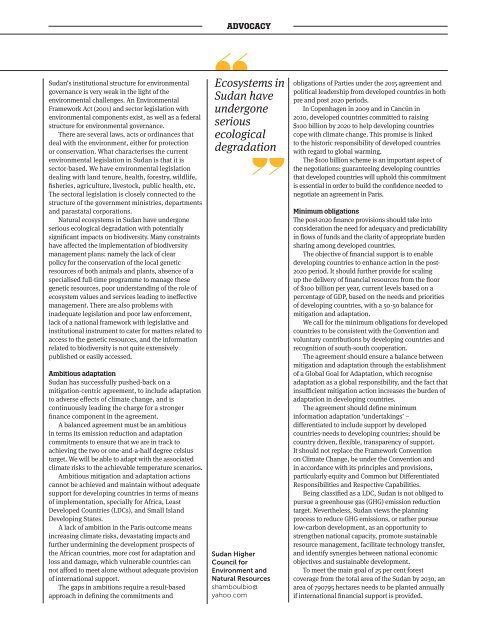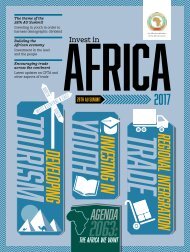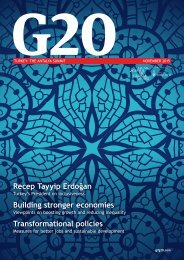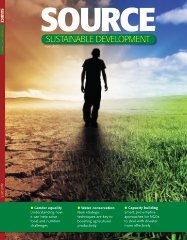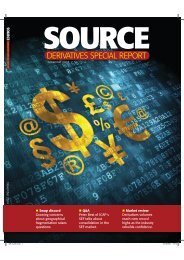G20 china_web
Create successful ePaper yourself
Turn your PDF publications into a flip-book with our unique Google optimized e-Paper software.
ADVOCACY<br />
Sudan’s institutional structure for environmental<br />
governance is very weak in the light of the<br />
environmental challenges. An Environmental<br />
Framework Act (2001) and sector legislation with<br />
environmental components exist, as well as a federal<br />
structure for environmental governance.<br />
There are several laws, acts or ordinances that<br />
deal with the environment, either for protection<br />
or conservation. What characterises the current<br />
environmental legislation in Sudan is that it is<br />
sector-based. We have environmental legislation<br />
dealing with land tenure, health, forestry, wildlife,<br />
fisheries, agriculture, livestock, public health, etc.<br />
The sectoral legislation is closely connected to the<br />
structure of the government ministries, departments<br />
and parastatal corporations.<br />
Natural ecosystems in Sudan have undergone<br />
serious ecological degradation with potentially<br />
significant impacts on biodiversity. Many constraints<br />
have affected the implementation of biodiversity<br />
management plans: namely the lack of clear<br />
policy for the conservation of the local genetic<br />
resources of both animals and plants, absence of a<br />
specialised full-time programme to manage these<br />
genetic resources, poor understanding of the role of<br />
ecosystem values and services leading to ineffective<br />
management. There are also problems with<br />
inadequate legislation and poor law enforcement,<br />
lack of a national framework with legislative and<br />
institutional instrument to cater for matters related to<br />
access to the genetic resources, and the information<br />
related to biodiversity is not quite extensively<br />
published or easily accessed.<br />
Ambitious adaptation<br />
Sudan has successfully pushed-back on a<br />
mitigation-centric agreement, to include adaptation<br />
to adverse effects of climate change, and is<br />
continuously leading the charge for a stronger<br />
finance component in the agreement.<br />
A balanced agreement must be an ambitious<br />
in terms its emission reduction and adaptation<br />
commitments to ensure that we are in track to<br />
achieving the two or one-and-a-half degree celsius<br />
target. We will be able to adapt with the associated<br />
climate risks to the achievable temperature scenarios.<br />
Ambitious mitigation and adaptation actions<br />
cannot be achieved and maintain without adequate<br />
support for developing countries in terms of means<br />
of implementation, specially for Africa, Least<br />
Developed Countries (LDCs), and Small Island<br />
Developing States.<br />
A lack of ambition in the Paris outcome means<br />
increasing climate risks, devastating impacts and<br />
further undermining the development prospects of<br />
the African countries, more cost for adaptation and<br />
loss and damage, which vulnerable countries can<br />
not afford to meet alone without adequate provision<br />
of international support.<br />
The gaps in ambitions require a result-based<br />
approach in defining the commitments and<br />
Ecosystems in<br />
Sudan have<br />
undergone<br />
serious<br />
ecological<br />
degradation<br />
Sudan Higher<br />
Council for<br />
Environment and<br />
Natural Resources<br />
shamboulbio@<br />
yahoo.com<br />
obligations of Parties under the 2015 agreement and<br />
political leadership from developed countries in both<br />
pre and post 2020 periods.<br />
In Copenhagen in 2009 and in Cancún in<br />
2010, developed countries committed to raising<br />
$100 billion by 2020 to help developing countries<br />
cope with climate change. This promise is linked<br />
to the historic responsibility of developed countries<br />
with regard to global warming.<br />
The $100 billion scheme is an important aspect of<br />
the negotiations: guaranteeing developing countries<br />
that developed countries will uphold this commitment<br />
is essential in order to build the confidence needed to<br />
negotiate an agreement in Paris.<br />
Minimum obligations<br />
The post-2020 finance provisions should take into<br />
consideration the need for adequacy and predictability<br />
in flows of funds and the clarity of appropriate burden<br />
sharing among developed countries.<br />
The objective of financial support is to enable<br />
developing countries to enhance action in the post-<br />
2020 period. It should further provide for scaling<br />
up the delivery of financial resources from the floor<br />
of $100 billion per year, current levels based on a<br />
percentage of GDP, based on the needs and priorities<br />
of developing countries, with a 50-50 balance for<br />
mitigation and adaptation.<br />
We call for the minimum obligations for developed<br />
countries to be consistent with the Convention and<br />
voluntary contributions by developing countries and<br />
recognition of south-south cooperation.<br />
The agreement should ensure a balance between<br />
mitigation and adaptation through the establishment<br />
of a Global Goal for Adaptation, which recognise<br />
adaptation as a global responsibility, and the fact that<br />
insufficient mitigation action increases the burden of<br />
adaptation in developing countries.<br />
The agreement should define minimum<br />
information adaptation ‘undertakings’ –<br />
differentiated to include support by developed<br />
countries-needs to developing countries; should be<br />
country driven, flexible, transparency of support.<br />
It should not replace the Framework Convention<br />
on Climate Change, be under the Convention and<br />
in accordance with its principles and provisions,<br />
particularly equity and Common but Differentiated<br />
Responsibilities and Respective Capabilities.<br />
Being classified as a LDC, Sudan is not obliged to<br />
pursue a greenhouse gas (GHG) emission reduction<br />
target. Nevertheless, Sudan views the planning<br />
process to reduce GHG emissions, or rather pursue<br />
low-carbon development, as an opportunity to<br />
strengthen national capacity, promote sustainable<br />
resource management, facilitate technology transfer,<br />
and identify synergies between national economic<br />
objectives and sustainable development.<br />
To meet the main goal of 25 per cent forest<br />
coverage from the total area of the Sudan by 2030, an<br />
area of 790795 hectares needs to be planted annually<br />
if international financial support is provided.


